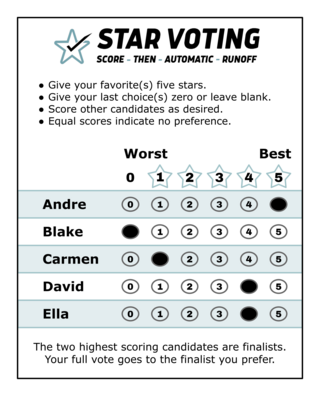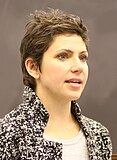
Approval voting is an electoral system in which voters can select any number of candidates instead of selecting only one.

The two-round system (TRS), also known as runoff voting, second ballot, or ballotage, is a voting method used to elect a single candidate. The first round is held using simple plurality to choose the top-two candidates, and then in the second round the winner is chosen by majority vote. The two-round system is widely used in the election of legislative bodies and directly elected presidents.
Primary elections, or direct primary, are voting processes by which voters can indicate their preference for their party's candidate, or a candidate in general, in an upcoming general election, local election, or by-election. Depending on the country and administrative divisions within the country, voters might consist of the general public in what is called an open primary, or solely the members of a political party in what is called a closed primary. In addition to these, there are other variants on primaries that are used by many countries holding elections throughout the world.

FairVote is a 501(c)(3) organization and lobbying group in the United States.
An open primary is a primary election that does not require voters to be affiliated with a political party in order to vote for partisan candidates. In a traditional open primary, voters may select one party's ballot and vote for that party's nomination. As in a closed primary, the highest voted candidate in each party then proceeds to the general election. In a nonpartisan blanket primary, all candidates appear on the same ballot and the two highest voted candidates proceed to the runoff election, regardless of party affiliation. The constitutionality of this system was affirmed by the Supreme Court of the United States in Washington State Grange v. Washington State Republican Party in 2008, whereas a partisan blanket primary was previously ruled to be unconstitutional in 2000. The arguments for open primaries are that voters can make independent choices, building consensus that the electoral process is not splintered or undermined by the presence of multiple political parties.
A nonpartisan blanket primary is a primary election in which all candidates for the same elected office run against each other at once, regardless of the political party. Partisan elections are, on the other hand, segregated by political party. Nonpartisan blanket primaries are slightly different from most other elections systems with two rounds/a runoff, also known as "jungle primaries" , in a few ways. The first round of a nonpartisan blanket primary is officially the "primary." Round two is the "general election." Round two must be held, even if one candidate receives a majority in the first round.
Instant-runoff voting (IRV) is a ranked voting method used in single-winner elections. IRV is more commonly known outside the US as the alternative vote or preferential voting. Today it is in use at a national level to elect the Australian House of Representatives, the National Parliament of Papua New Guinea, the President of Ireland and President of India. In Australia it is also used for elections to the legislative assemblies of all states and territories except Tasmania and the Australian Capital Territory, and for the Tasmanian Legislative Council.
The Independent Party of Oregon (IPO) is a centrist political party in the U.S. state of Oregon with more than 140,000 registrants since its inception in January 2007. The IPO is Oregon's third-largest political party and the first political party other than the Democratic Party and Republican Party to be recognized by the state of Oregon as a major political party.
Electoral reform in the United States refers to efforts to change American elections and the electoral system used in the United States.
Electoral reform in Alaska refers to efforts to change the voting laws in this U.S. state. U.S. Senator John McCain and other Republicans endorsed a referendum to implement Instant Runoff Voting, after the conservative vote split between the Republican candidate and the Alaskan Independence Party candidate, allowing a Democrat to win the governorship. However, the League of Women Voters opposed it, citing the principle of one man, one vote, and the measure was defeated. Another issue is whether Alaska will join the National Popular Vote Interstate Compact and designate its three electors to the candidate winning the nationwide popular vote, rather than the winner of the state's vote. SB 138, a bill to do just that, was introduced in 2007, but was not approved.

Electoral reform in Colorado refers to efforts to change the voting laws in the Centennial State.

Ranked-choice voting (RCV) can refer to one of several ranked voting methods used in some cities and states in the United States. The term is not strictly defined, but most often refers to instant-runoff voting (IRV) or single transferable vote (STV).
Instant-runoff voting (IRV), also known as alternative vote (AV) or plurality loser, is a ranked-choice voting system that modifies plurality by repeatedly eliminating the last-place finisher until only one candidate is left. In the United States, IRV is often mistaken conflated with ranked-choice voting (RCV); however, this conflation is not completely standard, and social choice theorists tend to prefer more explicit terms.

The 2009 Burlington mayoral election was held in March 2009 for the city of Burlington, Vermont. This was the second mayoral election since the city's 2005 change to instant-runoff voting (IRV), after the 2006 mayoral election. In the 2009 election, incumbent Burlington mayor won reelection as a member of the Vermont Progressive Party, defeating Kurt Wright in the final round with 48% of the vote.

An electoral system or voting system is a set of rules that determine how elections and referendums are conducted and how their results are determined. Electoral systems are used in politics to elect governments, while non-political elections may take place in business, non-profit organisations and informal organisations. These rules govern all aspects of the voting process: when elections occur, who is allowed to vote, who can stand as a candidate, how ballots are marked and cast, how the ballots are counted, how votes translate into the election outcome, limits on campaign spending, and other factors that can affect the result. Political electoral systems are defined by constitutions and electoral laws, are typically conducted by election commissions, and can use multiple types of elections for different offices.

STAR voting is an electoral system for single-seat elections. The name stands for "Score then Automatic Runoff", referring to the fact that this system is a combination of score voting, to pick two finalists with the highest total scores, followed by an "automatic runoff" in which the finalist who is preferred on more ballots wins. It is a type of cardinal voting electoral system.

The Center for Election Science (CES) is an American 501(c)(3) organization that focuses on voter education and promoting election science. The organization promotes electoral systems favored by social choice theorists, primarily cardinal voting methods such as approval and score voting. They have their early roots in effective altruism.

The 2021 St. Louis mayoral election occurred in two stages, with a unified primary on March 2, 2021, and a two-candidate general election on April 6, 2021. The election was the first in the nation to use approval voting for a primary. Incumbent Democratic mayor Lyda Krewson was eligible to seek re-election to a second term in office, but chose to retire.

Alaska Measure 2 was a ballot initiative approved by voters in Alaska as part of the 2020 United States elections. The proposal switched Alaska's primary system to a non-partisan blanket primary. The top four candidates progress to the general election, which is conducted with ranked-choice voting. Voting for U.S. president will continue to utilize primaries based on political party, but ranked-choice voting will still be used in the general election. The initiative also requires additional disclosures of campaign financing.
A top-four primary or top-four ranked-choice voting is an election method using a nonpartisan blanket primary where up to four candidates, those with the most votes, advance from a first round of SNTV voting, regardless of the political party. The round two (general) election, held some weeks later, uses instant-runoff voting to confirm a winner among the top set of candidates.

















